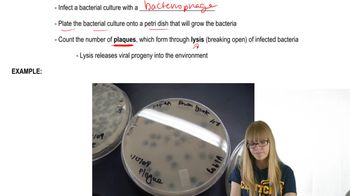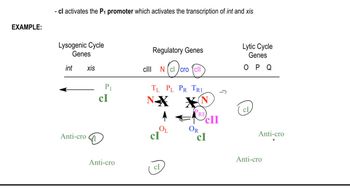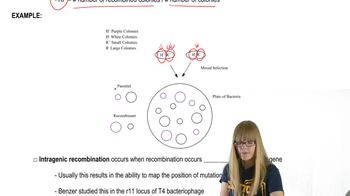Table of contents
- 1. Introduction to Genetics51m
- 2. Mendel's Laws of Inheritance3h 37m
- 3. Extensions to Mendelian Inheritance2h 41m
- 4. Genetic Mapping and Linkage2h 28m
- 5. Genetics of Bacteria and Viruses1h 21m
- 6. Chromosomal Variation1h 48m
- 7. DNA and Chromosome Structure56m
- 8. DNA Replication1h 10m
- 9. Mitosis and Meiosis1h 34m
- 10. Transcription1h 0m
- 11. Translation58m
- 12. Gene Regulation in Prokaryotes1h 19m
- 13. Gene Regulation in Eukaryotes44m
- 14. Genetic Control of Development44m
- 15. Genomes and Genomics1h 50m
- 16. Transposable Elements47m
- 17. Mutation, Repair, and Recombination1h 6m
- 18. Molecular Genetic Tools19m
- 19. Cancer Genetics29m
- 20. Quantitative Genetics1h 26m
- 21. Population Genetics50m
- 22. Evolutionary Genetics29m
5. Genetics of Bacteria and Viruses
Bacteriophage Genetics
Problem 12
Textbook Question
Define plaque, lysogeny, and prophage.
 Verified step by step guidance
Verified step by step guidance1
Step 1: Define 'plaque' in the context of bacteriophages. A plaque is a clear area on a bacterial lawn (a layer of bacteria grown on an agar plate) where bacteriophages have infected and lysed the bacterial cells, resulting in a visible zone of clearing.
Step 2: Explain 'lysogeny'. Lysogeny is a process where a bacteriophage integrates its genetic material into the host bacterium's genome, becoming a prophage. In this state, the phage DNA is replicated along with the host DNA without causing lysis of the host cell.
Step 3: Define 'prophage'. A prophage is the form of a bacteriophage when its DNA is integrated into the host bacterium's genome during the lysogenic cycle. The prophage can remain dormant within the host genome until certain conditions trigger its reactivation.
Step 4: Discuss the relationship between these terms. Plaques are the result of the lytic cycle of bacteriophages, while lysogeny and prophage are part of the lysogenic cycle, where the phage DNA is incorporated into the host genome without immediate destruction of the host.
Step 5: Highlight the significance of these concepts in genetics. Understanding plaques, lysogeny, and prophages is crucial for studying bacteriophage life cycles, bacterial genetics, and the mechanisms of horizontal gene transfer.
Recommended similar problem, with video answer:
 Verified Solution
Verified SolutionThis video solution was recommended by our tutors as helpful for the problem above
Video duration:
1mPlay a video:
Was this helpful?
Key Concepts
Here are the essential concepts you must grasp in order to answer the question correctly.
Plaque
In microbiology, a plaque refers to a clear zone that appears on a bacterial lawn due to the lysis of bacteria by bacteriophages. When a bacteriophage infects a bacterium, it replicates and eventually causes the bacterium to burst, releasing new phages. This results in a visible area devoid of bacteria, which can be counted to determine the concentration of phages in a sample.
Recommended video:
Guided course

Plaques and Experiments
Lysogeny
Lysogeny is a viral replication cycle in which a bacteriophage integrates its genetic material into the host bacterium's genome, becoming a prophage. In this state, the viral DNA is replicated along with the host's DNA during cell division, allowing the virus to persist without killing the host. This can lead to a stable relationship between the virus and the host until conditions trigger the lytic cycle.
Recommended video:
Guided course

Decision Between Lytic and Lysogenic Cycles
Prophage
A prophage is the dormant form of a bacteriophage that has integrated its DNA into the host bacterium's chromosome during the lysogenic cycle. In this state, the prophage is replicated along with the host's DNA and can remain inactive for extended periods. Environmental factors or stress can induce the prophage to enter the lytic cycle, leading to the production of new phages and the eventual lysis of the host cell.
Recommended video:
Guided course

Plaques and Experiments

 3:44m
3:44mWatch next
Master Plaques and Experiments with a bite sized video explanation from Kylia Goodner
Start learningRelated Videos
Related Practice


